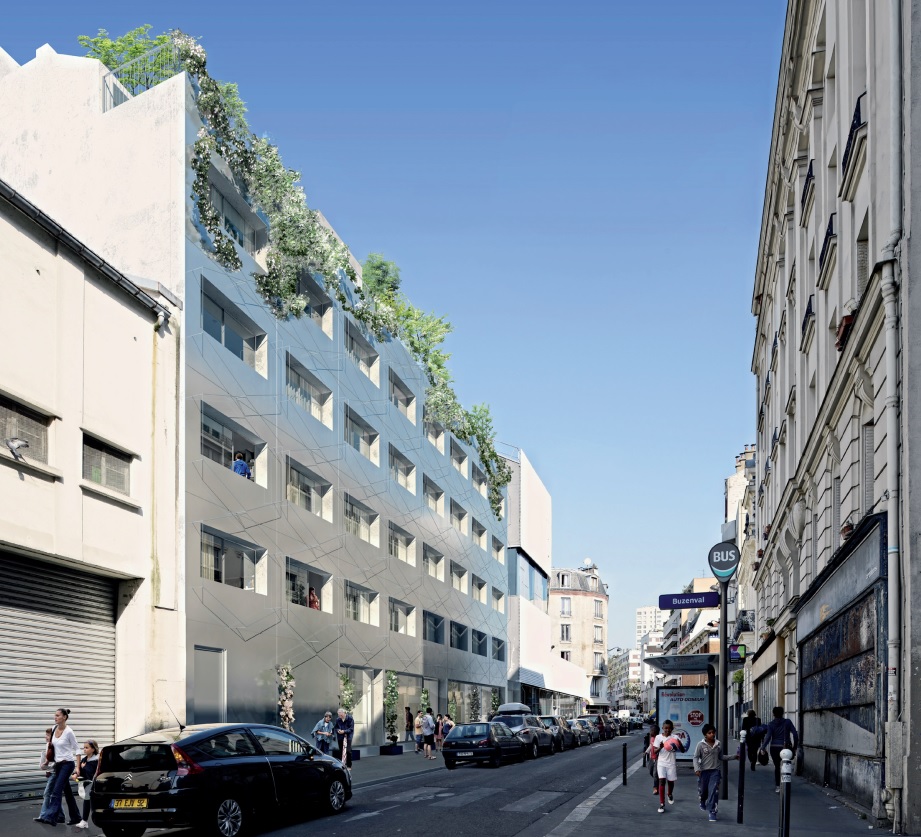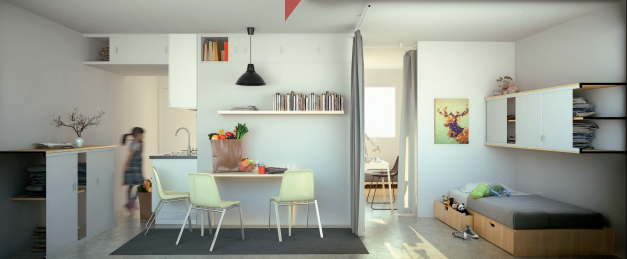
In short
The challenge
In France, there is a qualitative and a quantitative gap between supply and demand of affordable housing units. Social landlords are facing increasing difficulties in housing modest and very modest households in their new rental stock, especially in tense areas of supply and demand. The rents in the new rental stock are indeed higher than in the old amortized rental stock. Rent receipt levels are too high, excluding an increasing number of modest households from the social housing market.
What we offer
We want to reverse the design process of housing construction, building on the actual housing needs of a territory and designing a housing project which is adapted to the needs of the targeted population. The production of affordable housing can be obtained through collaborative steering using a tool called « global costing ». This tool takes into account all the constraints and objectives of the stakeholders (public/local authorities, landlords, constructors, architects, maintainers, future residents,…).
Our partners



Read more
In the recent years in France, the cost of housing has increased at a faster pace than that of disposable incomes, and particularly for people who live under the poverty line. This observation has been acknowledged in various statistical reports. It applies both between and within the social and private rental stocks[1]. The social rental stock is especially concerned by this issue : social landlords face increasing difficulties in housing modest and very modest households in their new rental stocks, particularly in areas of tense supply and demand. The rents in the new rental stock are indeed higher than in the old amortized rental stock.
In new social housing operations, rent levels per square metre are lower than those of the private rental stock. But when the surface area[2] and the rent charges[3] are taken into account, the absolute cost of housing is sometimes too high for modest households[4].
Furthermore, analyses of the supply of new social housing units in areas of tense supply and demand – particularly in the Greater Paris region – show a mismatch with the actual demand. This mismatch is both qualitative and quantitative.
From a quantitative point of view, the amount of newly built units being put into service (18,000 in 2012) is significatively lower than the estimated needs in social housing on the territory (21,000 in 2013 according to the SDRIF 2013-2030). The new housing stock has to be put in relationship with the stock of 560,000 active demands of access to social housing. Two thirds of these demands come from people who are not already living in social housing[5].
From a qualitative point of view, 11% of the new social housing units are financed through PLAI loans (loans related to lower levels of rent per sq.metre)[6], whereas 64% of the social housing residents and 73% of the social housing applicants have incomes which are lower than the PLAI income ceiling[7]. An analysis of the new social units in the Greater Paris region –with rent levels lower than 6€ per sq. metre – shows an overrepresentation of large-size housing units, which are often located in sensitive urabn areas[8]. Demands for small housing typologies (one-roomed or two-roomed flats) concentrate 48,5% of all the social housing applications in the Greater Paris region[9]. But these typologies only represent 29% of the units put into service and 12% of units put into service with rents lower than 6€/sq.metre.
These findings led us to the conviction that future residents had to be put at the centre of construction projects, so that they can be provided with housing units which actually match their needs and financial capacities. This requires involving the entire housing value chain so as to reduce the overall cost of new social housing units.
[1] The affordability ratio for households living in the private rental stock is 26% whereas the ratio for households living in the social rental stock is 21,5% (DREES, dossier solidarité et santé n°55). [2] According to the 2012 housing accounts (Commissariat Général du Développement Durable, 2014), the average surface areas in collective social housing is 63 sq.meters, whereas the average surface in the private rental stock is 52 sq.metres. [3] Rental charges in the social rental stock are usally 7% higher than those in the private rental stock. Charges include collective charges (maintenance, common areas, staff) and indivdual expenses (small repairs undertaken by tenants, insurance). For more information, please see our study on the global cost of housing. Source : Housing Accounts, 2010, USH. [4] In addition to this, the negative correlation between the limit covered by housing help – “APL” In France – and the real sepnding for lodging is significant. 81% of the rent under PLUS funding and 46% of the rent under PLAI funding are above the limits (Fondation Abbé Pierre, RPLS 2013, calculations USH-DEEF). [5] Number of active social housing demand in Greater Paris region by the end of May 2014 (Système National d’Enregistrement, AORIF). [6] PLAI funding is characterized by lower levels of rents per square metre than other types of funding (PLUS, PLS). In the Greater Paris region, in 2012, 11% of social housing units put into service are financed through PLAI loans. PLAI funding applies to units destined for people whose levels of income do not excede a given ceiling. [7] DRIHL, study on modest houshold access to housing (CESER). [8] 25% of the housing with rent under 6€ per sq. m are located in ZUS (sensitive urban area) against 16% for all the social housing in Greater Paris region. [9] Reminder: 48,3% of Greater Paris region households living under poverter threshold are isolated persons.
The study on the global cost of housing
Before identifying the potential areas of housing cost savings, it was necessary for us to measure the global cost of housing and to identify its different components. The Action Tank solicited the Boston Consulting Group to break down the different drivers of the cost of housing. A study was carried out with the support of Bouygues Habitat Social and Apogée (a social landlord association). The study focused on four new building operations. The operations were selected on the basis of their representativeness of the actual production in the Paris region and of their distance from the city of Paris. (To access the full study in French version only, please click here.). The perimeter that was retained for the computation of a global cost encompasses the traditional cost price of the operation (land price, construction price, fees) but also the funding costs as they appear in the financing plan, the maintenance charges, the utilization charges (recoverable/unrecoverable charges, charges directly paid by the tenant). The whole set of costs is computed on a 50-year period, taking into account hypotheses related to the increase in (energy) costs. The costs are then discounted and brought back to a cost per month per housing unit. As an example, the global cost of housing for a 6-floor building neighbouring Paris, comprised of 65 housing units, with an average surface area of 65 sq.metres, is 751€/unit
Building on the results of this study, working groups were set-up, bringing together landlords, managers, construction firms, architects, financers, engineering consulting firms. These people worked together during six months to validate the overall approach, ie. the global costing modelization method. They also tried to identify cost saving drivers in the areas of built environment, fluids, funding, and community involvement.
The next step for the Action Tank was to complement this first stakeholder approach of the global cost with another study which would break down the global cost for each stakeholder. The two areas of focus were :
- the cost for the tenant (affordability ratio, monthly disposable income after the rent and rent charges have been paid)
- the cost for the landlord (equity investment, balanced cashflow situation, net present value).
We have identified 70 mechanisms which can reduce the global cost of housing throughout the whole value chain. A subset of 40 mechanisms are compatible with each other. By combining them, we discovered that savings on the global cost of housing could reach 200€ per unit per month, compared to the initial cost of 751€ per unit per month. This amounts to a decrease of 26%. We believe it is possible to decrease the global cost of housing, by:
- Acting on all levels of costs, in a joint and coherent way, and at the earliest possible stage
- Involving the whole building ecosystem (project owners, architects, engineering consulting firms, construction firms, public authoriries, managers, residents) in a collaborative and balanced operation process
- Moving away from the « fetichist » construction cost thanks to the global cost modelization : in some cases, it is useful to increase the construction cost to reduce the global cost
- Adapting the mechanisms to the technical, economic and social context which is specific to each project
- Taking into account the profile of future residents to adjust the project to their needs and financial capabilities
- Anticipating the costs related to the support of residents throughout the process
Principles underlying our approach
Building on these works, the Action Tank developed a design methodology for the construction of new social housing units. This methodology relies on the global cost of housing, whose underlying principle is to adapt the housing units to the needs and financial capabilities of low-income households. The global cost of housing is a tool which operationalizes the steering of construction work. Projects are not exclusively steered by their cost price. They are steered by their global cost.
First, a profile analysis of the future residents in a given area must be undertaken. The analysis must point out their family compositions, their levels of income, their actual uses and needs, and what they can reasonably afford.
Second, the initial global cost of the project must be computed. The gap between this cost and what the residents can reasonably afford must be computed as well. Stakeholders must be informed and aware of this gap, in order to prepare for the third phase which consists in bridging the gap between the cost of the project and the maximum housing charge the residents can afford.
Matching housing demand and housing supply requires an iterative work using pre-identified mechanisms. The research of mechanisms has to be systematized. For each mechanism, a global cost modelization has to be undertaken. At this stage, a horizontal dialogue is required to avoid any information silo. The involvement of stakeholders who are not usually present in the design phase is necessary (maintainers, rental management staff…).
Finally, we believe it is important to push forward this approach in the later stages of construction and even after the residents’ move-in. We must ensure the global cost is taken into account in the future arbitrations as well as in the impact evaluation of the project.
This type of experiment is a powerful lab for landlords who wish to refine their maintenance strategies, for those who need a closer lookout on charges, or on the energy performance of buildings.
The mechanisms we used to reduce the global cost of housing
A typology:
- innovation in the diagnosis of the housing needs in a given area, in order for us to be able to suggest a building programme which matches the local needs (adapted housing typologies, surface areas, funding, products). This diagnosis has to be carried out in partnership with the project stakeholders (local authority, landlord, etc).
- innovation in the global costing tool and the affordability ratio of future residents
- innovation in the process of decision-making by proposing an approach based on transparent stakeholder collaboration
Two projects have been achieved to date and ten projects are currently underway.
The Action Tank has been involved in two design-construction operations with Eure Habitat, a social landlord based in Normandy (100 units).
The Action Tank has also provided project management services to social landlords, including:
- Help in the definition of projects’ specifications
- Co-development of a tool enabling different stakeholders to apprehend the impact of their choices on the global cost of the project. The tool was used to raise awareness but also to evaluate the submitted tenders
The two projects developed by Eure Habitat in Normandy lead to a 14 to 16% decrease in rent per sq. meter compared to the landlord’s usual rent ceiling. The total decrease in rent varied from 16 to 28%, thanks to an optimization of surface areas.
Work has also been done regarding the optimization of rental charges. In our experiment with ICF Habitat in Paris, we are trying to reduce them via a global performance contract, which will limit the operating costs of the project.
Furthermore, other projects are underway, including sale before completion contracts with our partner Bouygues Bâtiment Ile-de-France Habitat Social. The Action Tank has taken part in the « Réinventer Paris » call for projects. We came up with a social residence project, in partnership with Lerichemont – a subsidiary of RIVP. Our project relied on an innovative management system inducing a decrease ranging from 26% to 40% in rent + rental charges, for a given housing typology.
Our approach was also rewarded as part of a national Call for Expression of Interest that was issued by the National Agency for Urban Renovation (ANRU), in Stains, in the North of Paris.
We are currently looking for new fields of experiment in France, more specifically in the Greater Paris region. These projects can be mixed in terms of targeted population, in terms of products and in terms of funding sources.






